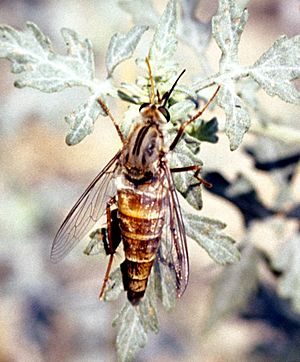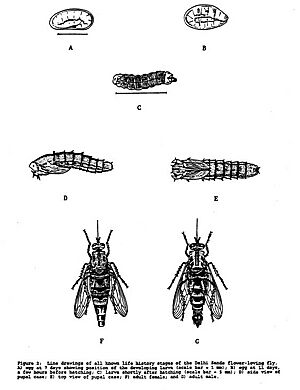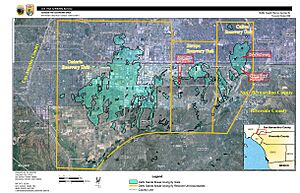Delhi Sands flower-loving fly facts for kids
Quick facts for kids Delhi Sands flower-loving fly |
|
|---|---|
 |
|
| Conservation status | |
| Scientific classification |
|
| Kingdom: | Animalia |
| Phylum: | Arthropoda |
| Class: | Insecta |
| Order: | Diptera |
| Family: | Mydidae |
| Genus: | Rhaphiomidas |
| Species: |
R. terminatus
|
| Subspecies: |
R. t. abdominalis
|
| Trinomial name | |
| Rhaphiomidas terminatus abdominalis Cazier, 1941
|
|
The Delhi Sands flower-loving fly (Rhaphiomidas terminatus abdominalis) is a special type of fly. It's part of the Mydidae family, known for their long bodies. This fly made history as the very first fly to be added to the Endangered Species List in the United States. This means it's in danger of disappearing forever.
This unique fly lives only in a specific area of Southern California. This area is called the Delhi Sand Dunes. It's a place with ancient sand dunes that used to cover a large area, about 40 square miles (100 km²). Sadly, most of this special habitat is now gone. Only about 2% of the original area remains untouched. The rest has been built over, forming towns like Colton, Fontana, Rancho Cucamonga, Rialto, and Ontario, California.
Adult Delhi Sands flower-loving flies are active for only a few weeks each year. They feed on flowers during the summer months, from June to September. Their home is shrinking because of new buildings, farms, and sand mining. Other problems include invasive plants, trash dumping, and off-road vehicles. More than 97% of their original home is already gone. Only a small part of what's left is suitable for these flies to live in.
The United States Fish and Wildlife Service officially listed this fly as endangered on September 23, 1993. This decision has caused a lot of debate. Some people in the area have tried to get the fly removed from the endangered list. They wanted to allow more building and development. However, this fly is not a pest and does not carry diseases. Scientists believe there might be 5 to 10 more insect species that only live in the Delhi Sands area. These include new types of scarab beetles, sand roaches, and Jerusalem crickets.
Contents
- What is the Delhi Sands Flower-Loving Fly?
- Where Does the Delhi Sands Flower-Loving Fly Live?
- What is the Life Cycle of the Delhi Sands Flower-Loving Fly?
- What is the Delhi Sands Ecosystem Like?
- What Threats Does the Delhi Sands Flower-Loving Fly Face?
- How Are People Helping the Delhi Sands Flower-Loving Fly?
What is the Delhi Sands Flower-Loving Fly?
The Delhi Sands flower-loving fly is a large insect. It belongs to the fly family called Mydidae. It has a long body, similar to a robber fly. But unlike robber flies, it has a long, tube-like mouthpart called a proboscis. It uses this proboscis to drink nectar from flowers, much like a butterfly.
This fly is about 1 inch (2.5 centimeters) long. It's orange-brown with dark brown oval spots on its upper body. It's a strong and fast flyer. It can even hover in the air, just like a hummingbird!
How is the Delhi Sands Flower-Loving Fly Related to Other Insects?
The group of flies that includes the Delhi Sands flower-loving fly is called Rhaphiomidas. Scientists used to think it belonged to a different family. But new studies show it's part of the Mydidae family. The way these flies are spread around the world is very interesting. Similar groups are found in South Africa, Chile, and Australia. This suggests that their ancestors lived on a supercontinent called Gondwana. This landmass broke apart more than 100 million years ago during the Mesozoic era.
The Rhaphiomidas group has 19 species and 5 subspecies in North America. They live in dry areas of the southwestern United States and Mexico. One species, the Acton flower-loving fly, helps pollinate a rare plant called the Santa Ana woolly star.
What are the Subspecies of Rhaphiomidas terminatus?
The species Rhaphiomidas terminatus has two subspecies. One is the El Segundo flower-loving fly (Rhaphiomidas terminatus terminatus). The other is the Delhi Sands flower-loving fly (Rhaphiomidas terminatus abdominalis). The El Segundo flower-loving fly is now believed to be extinct. This means the Delhi Sands flower-loving fly is the only one left of its kind.
Scientists first described the Delhi Sands flower-loving fly in 1941. At first, they thought it was a separate species. But later studies showed it was a subspecies of Rhaphiomidas terminatus.
Where Does the Delhi Sands Flower-Loving Fly Live?
All known groups of Delhi Sands flower-loving flies live very close to each other. They are found within an 8-mile (13 km) area. This area is near Interstate 10, around Colton and Rialto, in Riverside and San Bernardino Counties, California. Some of their homes are on land owned by the county or a public utility. Other parts are on private land. There might also be small areas where their habitat could be restored.
What is the Life Cycle of the Delhi Sands Flower-Loving Fly?
The Delhi Sands flower-loving fly goes through a complete change in its life. This includes four stages: egg, larva, pupa, and adult. We don't know exactly how long they live. But the larval stage might last two years or even longer. This depends on how much food is available, the temperature, and rainfall.
The adult flies are active in late summer. But the early stages (egg, larva, pupa) can be found all year round. Except for the adults, the fly spends its entire life cycle underground. The adults come out and become active in early summer.
How Do Delhi Sands Flower-Loving Flies Mate?
After mating, female flies lay their eggs in sandy soil. Scientists have observed captive flies. Male flies lived for about 3 days and did not eat. Female flies lived for 5 to 8 days. They became active around 10:00 am each day and became inactive around 5:00 pm.
What are the Eggs Like?
One female fly was seen laying 40 eggs in the sand. The eggs were small, about 1.5 by 3 millimeters. They were almost kidney-shaped and pure white with a slight pink shine.
Female flower-loving flies have special organs on their abdomen for laying eggs. These organs have strong spines that can spin quickly. This helps them drill into sandy soil. They can insert their abdomen almost completely underground. This allows them to place eggs 1 to 2 inches (3 to 5 centimeters) deep. This keeps the eggs cooler and more moist than on the surface. Most eggs are laid in the shade of shrubs. The eggs hatch into larvae in 11 to 12 days.
What are the Larvae Like?
The young stages of the Delhi Sands flower-loving fly are made for burrowing. They live underground in sandy soil. Their body shape helps them dig through the sand. The pupa (the stage before adult) has a large spine on its head. This might help it tunnel through the soil when it's ready to emerge.
How Do Adult Flies Emerge?
When they are ready, the pupae push their front half out of the soil. This creates unique holes that are not made by other animals. The flight season for adult Delhi Sands flower-loving flies is from early June to early September. They are active during the warmest parts of the day, usually from 10:00 am to 2:00 pm. They don't fly when it's cloudy, rainy, or very windy. If it's windy, they might be found resting in plants. Egg-laying usually happens in the late afternoon, between 2:00 pm and 5:00 pm, when temperatures start to cool down.
What Do Delhi Sands Flower-Loving Flies Eat?
Delhi Sands flower-loving flies have rarely been seen drinking nectar. When they do, it's very quick, only 2 to 10 seconds. They have only been observed feeding on the flowers of the California buckwheat. Other flowers are available, but the flies haven't been seen visiting them.
Scientists tried to feed the larvae of these flies in captivity. They offered different foods, but the larvae refused to eat anything. They wouldn't eat small beetle larvae, fruit fly larvae, or sand dune cockroach nymphs. The larvae also didn't try to eat each other, even when they were starving. All the captive larvae died within 15 days. So, it's still a mystery what the young stages of these flies eat. They might be plant-eaters, decomposers, or meat-eaters.
Who Are Their Predators?
The Argentine ant (Iriodomyrmex humilis), an introduced species, has been seen attacking and killing newly emerged adult Delhi Sands flower-loving flies. Large robber flies are also known to hunt Rhaphiomidas flies. Other animals that might eat adult flies include dragonflies and insect-eating birds. The young stages (eggs, larvae, pupae) might be eaten by ants, other underground insects, and reptiles.
What is the Delhi Sands Ecosystem Like?
The Delhi Sands flower-loving fly lives in areas with fine sandy soils. These are often sand dunes that are held in place by sparse native plants. The Colton dunes formed from sand blown by the Santa Ana winds from the San Gabriel and San Bernardino Mountains. Over thousands of years, these dunes grew to cover about 40 square miles (100 km²). Even though the Santa Ana winds still blow sand, most of the dune system is gone. It has been replaced by cities and farms.
The soils in this area are called Delhi series soils. They are a very special and rare environment. Many unique plants and animals live here. This region, also known as the Colton Dunes, is the largest inland sand dune area in southern California outside of the desert.
What Plants and Animals Live in the Delhi Sands?
Plants found on the Colton Dunes include California buckwheat, California croton, deerweed, and California evening primrose. This habitat is home to several animals and plants that are found in only a few places. These include the California legless lizard, the San Diego horned lizard, the Delhi Sands metalmark butterfly, the Delhi Sands Jerusalem cricket, the convergent apiocerid fly, the Delhi Sands sandroach, and possibly Pringle’s monardella.
Much of the Colton Dunes area was used for farming, like grapes and citrus, since the 1800s. More recently, almost all the remaining land has been used for dairies, housing, and businesses. Most of the areas that could be restored are damaged. The Delhi Sands flower-loving fly now lives in less than 2% of its original range. The habitat today is only about half of what it was in 1975. Before European settlement, the fly likely lived throughout most of the Colton Dunes.
What Threats Does the Delhi Sands Flower-Loving Fly Face?
California's population grew very quickly in the 1960s and 1970s. This growth continues, especially in the San Bernardino County area. This growth has led to many changes in the land.
Historically, lands with Delhi series soil were used for farming. Today, activities that harm the Delhi Sands flower-loving fly include sand mining and building homes and businesses. People illegally collecting the flies is also a threat. Because of this danger, special "Critical Habitat" areas were not officially set aside for the fly. Since the fly was listed as endangered, new construction, like a hospital and other businesses, has destroyed some fly populations and their homes. Dumping cow manure and other trash has also harmed the habitat.
How Do Invasive Plants Threaten the Fly?
Plants that are not native to the area, called invasive exotic vegetation, severely damage the fly's habitat. These non-native plants include Russian thistle, horehound, mustard, cheeseweed, and many types of introduced grasses. These plants likely change the soil moisture. They can also make the soil physically unsuitable for the fly and other native underground insects. Areas with invasive plants have far fewer native insects than areas with native plants.
How Does Cow Manure Dumping Affect the Fly?
Large amounts of cow manure from local dairies have been dumped on several sites. These sites could have been restored for the Delhi Sands flower-loving fly. The manure smothers the animals, plants, and their habitat. It also provides a lot of nutrients for invasive plants like cheeseweed. Removing the manure and nutrients is very expensive and takes a long time. Restoring areas with manure is a low priority, even if they would otherwise be perfect homes for the fly.
How Are People Helping the Delhi Sands Flower-Loving Fly?
Areas where the Delhi Sands flower-loving fly lives, or where its habitat can be restored, have been grouped into three "Recovery Units." These units are based on how close they are, how similar their habitats are, and if flies can move between them. The three recovery units are: Ontario Recovery Unit, Jurupa Recovery Unit, and Colton Recovery Unit.
Each recovery unit includes areas where the fly lives or where its habitat can be restored. These areas only include places with Delhi Series soils. Historical records suggest the fly used to live widely throughout these three units. The recovery units do not include areas with homes, businesses, or other permanent human changes.




